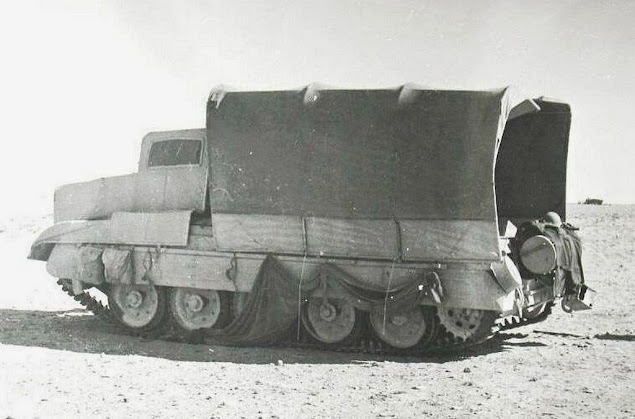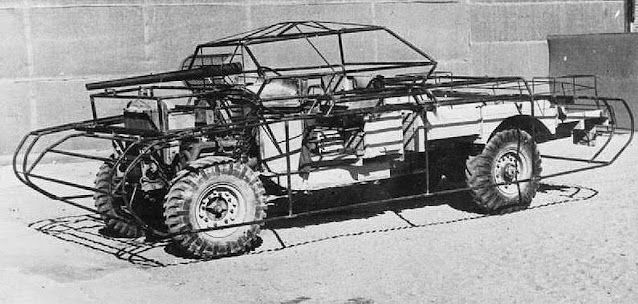
The problem of the command in a battlefield between tanks is very complex. The speed of the vehicles in movement and fluidity of the front conditions require that the Commander have to be very close to the action, to avoid errors and mistakes.
But somehow , he must be protected, because if the enemy identify the Commander, he becomes a priority target.
But somehow , he must be protected, because if the enemy identify the Commander, he becomes a priority target.
 |
| Battle between tanks … a very complicated thing!! |
A Command Vehicle must be robust, reliable, spacious (maps and extra radios) and not call attention to themselves. The specialized command vehicles normally are very characteristic and therefore, a true magnet for the enemy fire. As examples among the British, we can mention the AEC Dorchester and Guy Lizard.
 |
| AEC Dorchester command vehicle |
 |
| Guy Lizard command vehicle |
But these vehicles, although excellent, comfortable and spacious, were easily identifiable. One option was to disguise the appearance of the vehicle, to confuse him with another “anonymous” vehicle…
 |
|
AEC Dorchester disguised as a cargo truck
|
…but nonetheless, because they are not armored, the Commander was exposed to enemy fire. A tank would be the ideal option, but the problem was the lack of the internal space.
But the British had a very spacious tank: the Grant Cruiser Tank Mk I: The “Iron Cathedral”:
 |
| Grant Mk I Cruiser tank |
The Grant was one of the most roomy tanks, but it was still tight for a command vehicle.
Its 75mm gun (plus ammo shells) in the hull and its turret cramped with gun and machine guns turned the large on the tight.
The solution: Remove the armament of a Grant. The resulting tank would be extremely spacious: Grant Command Tank

 |
| Two views of the same Grant Command Tank in Sicily. Notice the absence of 75mm gun in the hull and the dummy gun (75mm fake) in the turret. |
Wow !!! That´s great !!! But I found another Gran Command Tank, with field adaptations in its hull to confuse the profile of the Grant with a Sherman (British worshiped disguises and tricks …). This is the beast:
 |
| Brand new Grant Command tank without markings… Notice the steel plates in the front hull, as a Shermie (in long distance…) The tank above is not the same as the photo below… |
 |
| Grant Command Tank in field…Notice the details, like front glacis, the ventilator bulge (fake) … everything to be similar to a Shermie |
The British disguised many tanks as trucks and also building “false” tanks to attract enemy fire … The Jerrys were extremely inventive!!
 |
| Matilda II with “sunshield” like a truck. |
 |
| Crusader dressing a truck sunshield… |
 |
| A “Crusader” in a 15 CWT light truck |
 |
| Other examples of disguises… |
Ok !!! But what was written on the side of the Grant, in this photo?? The British love put names of famous hotels on their Command Cars (Dorchester, the English name of AEC Command Vehicle is the name a famous hotel in London, famous for space and comfort …). There is a famous hotel with a name beginning with CLARI… and ending with ES … Googling and bingo: CLARIDGES HOTEL!!!!
 |
| Grant Command Tank “CLARIDGES” in field |
Solved the historical problem, go to the specifications of the best:Specs:


| Grant Command Tank “CLARIDGES” | |
|---|---|
| Type |
Armoured Command Vehicle
|
| Place of origin | United States |
| Service history | |
| Wars | World War II |
| Specifications | |
| Weight | 26 t |
| Length | 5.64 m |
| Width | 2.72 m |
| Height | 2,98 m |
| Crew | 2 + 1 Senior Office |
|
|
|
| Armor | up to 51mm |
|
Main armament
|
none |
|
Secondary armament
|
.303 Bren MG |
| Engine | Wright (Continental) R975 EC2 400 hp – 340 hp |
| Transmission | Synchromesh, 5 speeds forward, 1 reverse |
| Suspension | vertical volute spring |
| Ground clearance | 0.46 m |
| Fuel capacity | 662 liters |
|
Operational range
|
193 km |
| Speed | 42 km/h (road) 26 km/h (off-road) |
|
Steering system
|
controlled differential |